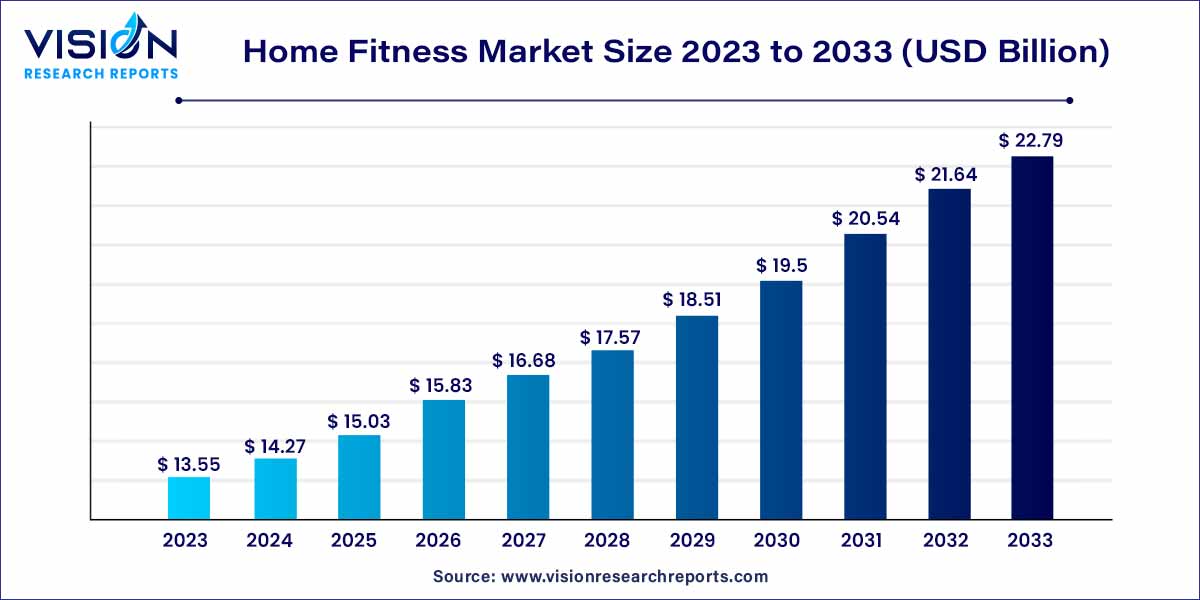The global home fitness market was estimated at USD 13.55 billion in 2023 and it is expected to surpass around USD 22.79 billion by 2033, poised to grow at a CAGR of 5.34% from 2024 to 2033. The home fitness market is driven by increasing global awareness of health and wellness, ongoing innovation in home fitness equipment, digital fitness platforms, and customization and personalization.

In recent years, the home fitness market has witnessed a significant surge in popularity, driven by a confluence of factors such as technological advancements, changing consumer lifestyles, and the global shift towards health and wellness. This burgeoning industry encompasses a wide array of products and services designed to facilitate convenient and effective workouts within the comfort of one's home.
The remarkable growth of the home fitness market can be attributed to a convergence of influential factors propelling its expansion. Technological advancements have played a pivotal role, as the integration of smart features into home fitness equipment offers users an interactive and connected workout experience. Simultaneously, changing lifestyles characterized by hectic schedules and an increased emphasis on health and wellness have driven individuals towards the convenience of home fitness solutions. The global trend towards prioritizing personal well-being has significantly contributed to the surge in demand for home fitness products and services. This market's resilience and growth are further underscored by the continual innovation witnessed in the sector, including the development of digital fitness platforms and wearable technologies, providing users with versatile and personalized fitness solutions. As the industry evolves, these growth factors collectively position the home fitness market as a dynamic and integral component of the contemporary wellness landscape.
| Report Coverage | Details |
| Market Size in 2023 | USD 13.55 billion |
| Revenue Forecast by 2033 | USD 22.79 billion |
| Growth rate from 2024 to 2033 | CAGR of 5.34% |
| Base Year | 2023 |
| Forecast Period | 2024 to 2033 |
| Market Analysis (Terms Used) | Value (US$ Million/Billion) or (Volume/Units) |
The home fitness market is categorized based on types, with segmentation into cardiovascular training equipment, strength training equipment, and other categories. Notably, the cardiovascular training equipment segment dominated the market in 2023. This segment covers a diverse range of machines, including treadmills, stationary cycles, elliptical trainers, and others. The market leadership of cardiovascular training equipment can be attributed to its widespread use and the inclusion of innovative features and technological advancements, contributing significantly to market expansion. Furthermore, the growing popularity of wearable devices and fitness apps has generated a heightened demand for cardiovascular training fitness equipment that seamlessly integrates with cutting-edge technologies such as Internet of Things (IoT) devices, cloud computing, and mobile applications.
The market is divided into distribution channels, namely online and offline, and in 2023, the offline segment took the lead in market share. Offline fitness stores have become increasingly popular due to consumers' inclination towards personalized shopping experiences, where a diverse range of products and expert advice are readily available. The rise of omnichannel retail is noteworthy, enabling customers to choose between online, in-store, or a combination of both for added convenience and broader accessibility. Additionally, traditional fitness distribution channels and in-person fitness experiences persist in playing a crucial role in the market landscape.
In 2023, North America asserted its dominance in the market, primarily driven by a heightened awareness of health among consumers and a widespread embrace of healthy lifestyles focused on weight management, physical well-being, enhanced body stamina, and muscular strength.

The substantial population in North America characterized as obese or overweight significantly contributes to the region's market demand. Moreover, the implementation of increasing government regulations aimed at fostering health consciousness among citizens has further solidified North America's position as the leading force in the industry.
By Type
By Distribution Channel
By Region
Chapter 1. Introduction
1.1. Research Objective
1.2. Scope of the Study
1.3. Definition
Chapter 2. Research Methodology
2.1. Research Approach
2.2. Data Sources
2.3. Assumptions & Limitations
Chapter 3. Executive Summary
3.1. Market Snapshot
Chapter 4. Market Variables and Scope
4.1. Introduction
4.2. Market Classification and Scope
4.3. Industry Value Chain Analysis
4.3.1. Raw Material Procurement Analysis
4.3.2. Sales and Distribution Channel Analysis
4.3.3. Downstream Buyer Analysis
Chapter 5. COVID 19 Impact on Home Fitness Market
5.1. COVID-19 Landscape: Home Fitness Industry Impact
5.2. COVID 19 - Impact Assessment for the Industry
5.3. COVID 19 Impact: Global Major Government Policy
5.4. Market Trends and Opportunities in the COVID-19 Landscape
Chapter 6. Market Dynamics Analysis and Trends
6.1. Market Dynamics
6.1.1. Market Drivers
6.1.2. Market Restraints
6.1.3. Market Opportunities
6.2. Porter’s Five Forces Analysis
6.2.1. Bargaining power of suppliers
6.2.2. Bargaining power of buyers
6.2.3. Threat of substitute
6.2.4. Threat of new entrants
6.2.5. Degree of competition
Chapter 7. Competitive Landscape
7.1.1. Company Market Share/Positioning Analysis
7.1.2. Key Strategies Adopted by Players
7.1.3. Vendor Landscape
7.1.3.1. List of Suppliers
7.1.3.2. List of Buyers
Chapter 8. Global Home Fitness Market, By Type
8.1. Home Fitness Market, by Type, 2024-2033
8.1.1. Cardiovascular Training Equipment
8.1.1.1. Market Revenue and Forecast (2021-2033)
8.1.2. Strength Training Equipment
8.1.2.1. Market Revenue and Forecast (2021-2033)
8.1.3. Others
8.1.3.1. Market Revenue and Forecast (2021-2033)
Chapter 9. Global Home Fitness Market, By Distribution Channel
9.1. Home Fitness Market, by Distribution Channel, 2024-2033
9.1.1. Online
9.1.1.1. Market Revenue and Forecast (2021-2033)
9.1.2. Offline
9.1.2.1. Market Revenue and Forecast (2021-2033)
Chapter 10. Global Home Fitness Market, Regional Estimates and Trend Forecast
10.1. North America
10.1.1. Market Revenue and Forecast, by Type (2021-2033)
10.1.2. Market Revenue and Forecast, by Distribution Channel (2021-2033)
10.1.3. U.S.
10.1.3.1. Market Revenue and Forecast, by Type (2021-2033)
10.1.3.2. Market Revenue and Forecast, by Distribution Channel (2021-2033)
10.1.4. Rest of North America
10.1.4.1. Market Revenue and Forecast, by Type (2021-2033)
10.1.4.2. Market Revenue and Forecast, by Distribution Channel (2021-2033)
10.2. Europe
10.2.1. Market Revenue and Forecast, by Type (2021-2033)
10.2.2. Market Revenue and Forecast, by Distribution Channel (2021-2033)
10.2.3. UK
10.2.3.1. Market Revenue and Forecast, by Type (2021-2033)
10.2.3.2. Market Revenue and Forecast, by Distribution Channel (2021-2033)
10.2.4. Germany
10.2.4.1. Market Revenue and Forecast, by Type (2021-2033)
10.2.4.2. Market Revenue and Forecast, by Distribution Channel (2021-2033)
10.2.5. France
10.2.5.1. Market Revenue and Forecast, by Type (2021-2033)
10.2.5.2. Market Revenue and Forecast, by Distribution Channel (2021-2033)
10.2.6. Rest of Europe
10.2.6.1. Market Revenue and Forecast, by Type (2021-2033)
10.2.6.2. Market Revenue and Forecast, by Distribution Channel (2021-2033)
10.3. APAC
10.3.1. Market Revenue and Forecast, by Type (2021-2033)
10.3.2. Market Revenue and Forecast, by Distribution Channel (2021-2033)
10.3.3. India
10.3.3.1. Market Revenue and Forecast, by Type (2021-2033)
10.3.3.2. Market Revenue and Forecast, by Distribution Channel (2021-2033)
10.3.4. China
10.3.4.1. Market Revenue and Forecast, by Type (2021-2033)
10.3.4.2. Market Revenue and Forecast, by Distribution Channel (2021-2033)
10.3.5. Japan
10.3.5.1. Market Revenue and Forecast, by Type (2021-2033)
10.3.5.2. Market Revenue and Forecast, by Distribution Channel (2021-2033)
10.3.6. Rest of APAC
10.3.6.1. Market Revenue and Forecast, by Type (2021-2033)
10.3.6.2. Market Revenue and Forecast, by Distribution Channel (2021-2033)
10.4. MEA
10.4.1. Market Revenue and Forecast, by Type (2021-2033)
10.4.2. Market Revenue and Forecast, by Distribution Channel (2021-2033)
10.4.3. GCC
10.4.3.1. Market Revenue and Forecast, by Type (2021-2033)
10.4.3.2. Market Revenue and Forecast, by Distribution Channel (2021-2033)
10.4.4. North Africa
10.4.4.1. Market Revenue and Forecast, by Type (2021-2033)
10.4.4.2. Market Revenue and Forecast, by Distribution Channel (2021-2033)
10.4.5. South Africa
10.4.5.1. Market Revenue and Forecast, by Type (2021-2033)
10.4.5.2. Market Revenue and Forecast, by Distribution Channel (2021-2033)
10.4.6. Rest of MEA
10.4.6.1. Market Revenue and Forecast, by Type (2021-2033)
10.4.6.2. Market Revenue and Forecast, by Distribution Channel (2021-2033)
10.5. Latin America
10.5.1. Market Revenue and Forecast, by Type (2021-2033)
10.5.2. Market Revenue and Forecast, by Distribution Channel (2021-2033)
10.5.3. Brazil
10.5.3.1. Market Revenue and Forecast, by Type (2021-2033)
10.5.3.2. Market Revenue and Forecast, by Distribution Channel (2021-2033)
10.5.4. Rest of LATAM
10.5.4.1. Market Revenue and Forecast, by Type (2021-2033)
10.5.4.2. Market Revenue and Forecast, by Distribution Channel (2021-2033)
Chapter 11. Company Profiles
11.1. Impulse Health Technology Co. Ltd.
11.1.1. Company Overview
11.1.2. Product Offerings
11.1.3. Financial Performance
11.1.4. Recent Initiatives
11.2. Core Health & Fitness
11.2.1. Company Overview
11.2.2. Product Offerings
11.2.3. Financial Performance
11.2.4. Recent Initiatives
11.3. Precor Incorporated
11.3.1. Company Overview
11.3.2. Product Offerings
11.3.3. Financial Performance
11.3.4. Recent Initiatives
11.4. Torque Fitness
11.4.1. Company Overview
11.4.2. Product Offerings
11.4.3. Financial Performance
11.4.4. LTE Scientific
11.5. Technogym
11.5.1. Company Overview
11.5.2. Product Offerings
11.5.3. Financial Performance
11.5.4. Recent Initiatives
11.6. TRUE
11.6.1. Company Overview
11.6.2. Product Offerings
11.6.3. Financial Performance
11.6.4. Recent Initiatives
11.7. Nautilus Inc.
11.7.1. Company Overview
11.7.2. Product Offerings
11.7.3. Financial Performance
11.7.4. Recent Initiatives
11.8. Life Fitness (KPS Capital)
11.8.1. Company Overview
11.8.2. Product Offerings
11.8.3. Financial Performance
11.8.4. Recent Initiatives
11.9. Shandong EM Health Industry Group Co. Ltd.
11.9.1. Company Overview
11.9.2. Product Offerings
11.9.3. Financial Performance
11.9.4. Recent Initiatives
11.10. Icon Health & Fitness
11.10.1. Company Overview
11.10.2. Product Offerings
11.10.3. Financial Performance
11.10.4. Recent Initiatives
Chapter 12. Research Methodology
12.1. Primary Research
12.2. Secondary Research
12.3. Assumptions
Chapter 13. Appendix
13.1. About Us
13.2. Glossary of Terms
 Cross-segment Market Size and Analysis for
Mentioned Segments
Cross-segment Market Size and Analysis for
Mentioned Segments
 Additional Company Profiles (Upto 5 With No Cost)
Additional Company Profiles (Upto 5 With No Cost)
 Additional Countries (Apart From Mentioned Countries)
Additional Countries (Apart From Mentioned Countries)
 Country/Region-specific Report
Country/Region-specific Report
 Go To Market Strategy
Go To Market Strategy
 Region Specific Market Dynamics
Region Specific Market Dynamics Region Level Market Share
Region Level Market Share Import Export Analysis
Import Export Analysis Production Analysis
Production Analysis Others
Others